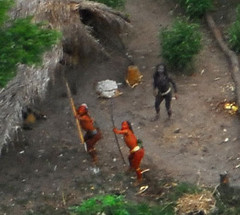MASSACRE OF AMAZON TRIBE BY DRUG TRAFFICKERS IS FEARED

There's a long and ugly history of civilization's addiction to consumption and development (oil and logging have been major culprits) destroying indigenous cultures in Amazonia. Now, drug traffickers may be using assault weapons against bows and arrows.
Here is the latest from National Geographic NewsWatch
by Scott Wallace
Five Brazilian Indian rights officials are holding out in a remote jungle outpost in a desperate attempt to protect uncontacted indigenous groups from heavily-armed drug traffickers who have moved into the area from Peru in the past two weeks, according to dispatches from the scene. Officials fear the traffickers may have unleashed a manhunt to track down and exterminate the highly vulnerable tribal populations in order to clear the forests for their coca-growing operations.
The drama began last month, when Asháninka Indians three hours upstream from the base warned by two-way radio that a heavily armed band of intruders had crossed the border from Peru into Brazil. Nearly two weeks later, 40 armed men appeared in the dense forests around the control post, which sits on the banks of the Xinane River, about 20 miles (32 kilometers) inside Brazil’s border in the western Amazonian state of Acre.
The post is operated by the “Envira Ethno-Environmental Protection Front,” and staffed by the Department of Isolated Indians, a special unit within Brazil’s Indian affairs agency, known as FUNAI. The outpost is intended to stem the flow of intruders into the headwaters of the Envira River, a pristine rainforest habitat where several isolated indigenous communities have taken refuge, shunning contact with the outside world. (Related National Geographic News story: PHOTO IN THE NEWS: “Uncontacted” Tribe Seen in Amazon)
While the control post has effectively blocked intruders moving upriver from within Brazil, it is ill-prepared to defend against infiltrations from the Peruvian side of the border, particularly on the scale of the current intrusion.
Outmanned and outgunned, the FUNAI personnel fled the outpost, which the gang overran on July 23. It took a week for Brazilian Federal Police and Army troops to respond to the incursion, dropping in by helicopter to regain control of the Xinane base. But the agents withdrew after a sweep of the nearby forest turned up a lone suspect. Unsatisfied with the failure of the police and military to remain in the area, the FUNAI team reoccupied the outpost this past Friday, August 5, fearing a massacre of the Indians they are duty-bound to protect.
“This situation could be the one of the gravest blows we’ve seen to efforts to protect isolated Indians in the past decade,” wrote Carlos Travassos, head of the Department of Isolated Indians, in an email to his colleagues from the Xanane base. Travassos is one of the five officials who returned to the base on Friday, despite warnings from the Federal Police that it was not safe to do so. The team has discovered clear signs that the traffickers remain in woods enveloping the base — fresh footprints, trampled underbrush, and a camp, where they found a backpack containing shotgun shells that had been looted from the FUNAI base, and more ominously, a broken arrow most likely seized from one of the uncontacted tribes in the area. Travassos said that interrogation of the suspect convinced him that some kind of atrocity had been committed in the nearby woodlands. “I was left with the strong impression that these guys had killed the Indians, at least a bunch of them,” Travassos wrote.
The FUNAI agents are accompanied by the veteran indigenous rights activist and scout José Carlos Meirelles, who supervised the Envira Front for FUNAI for 23 years. Now retired from FUNAI and working for the state government of Acre, Meirelles writes: “The fact is that we will remain here until someone (in the government) believes that an invasion of Brazilian territory by a group of Peruvian paramilitaries is something that merits attention.”
On Saturday, Travassos reported that Asháninka Indians from upriver had arrived at the outpost to bolster the FUNAI arsenal with much-needed rifles to fend off a possible attack.
The Xinane outpost is in the same region where Meirelles has twice taken journalists by aircraft on overflights to film and photograph a settlement of uncontacted Indians deep in the forest. Images of naked Indians in red body paint electrified much of the world when broadcast by the BBC earlier this year. In the BBC’s report, Meirelles called the Indians in the clearing below “the last free people on Earth.”
Suvival International has an older video with incredible live footage of one of the tribes:






No comments:
Post a Comment